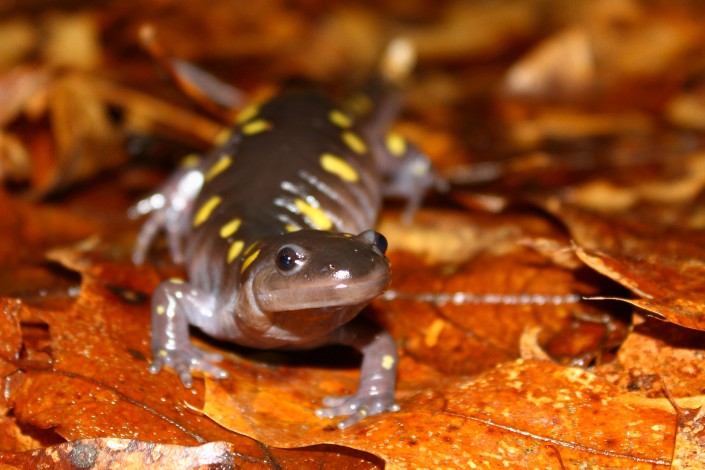Morning After Migration
POST #3 ON THE 2013 AMPHIBIAN MIGRATION
by MacKenzie Hall, Amphibian Crossing Project Coordinator

Following Monday’s all-night amphibian foray – and the prolonged terror/adrenaline rush of playing real-life Frogger – I drove home through a rainy sunrise on Tuesday. According to a weather app on my phone, the rain would keep falling all day and end (wouldn’t you know) right around sunset. “You gotta be kidding me,” I think is what I slurred.
Warm nighttime rain is the simple cue for mass movement, like what we had before dawn that day. But nature is seldom that simple, so the task of monitoring an amphibian migration can get hairy. The warm, soaking daytime rain would get the attention of those slumbering frogs and salamanders. Even if it stopped before dark, the wet ground and road would entice some of them to move. Maybe a lot of them? And right at the time when nighttime traffic would be heaviest on the roads.
So we sided with caution and rallied the teams to hit the streets at dusk. I went back to Byram to lead a group of volunteers there while others covered different hot-spots.
The rain did end early – earlier than expected even – and by nightfall our team was spreading out over a damp road. It was a relief to see that a migration was happening anyway, albeit at a slower pace. And the cars were filing through our setup (cones and signs, buffered by police) in threes and fours…99 vehicles in the first hour! Basically, there was a car for every salamander that dared to cross the white line.
We did our best to stay ahead of the traffic. By 11:00 pm the temperature was dropping, the road was drying, traffic was slowing, and so were the amphibians. We paced the road below a starry sky with Orion front and center. We had tallied another 175 spotted salamanders, 41 Jefferson’s salamanders, and 52 spring peepers. Despite the heavy car flow early on, more than 85% of those animals made it to the safe side of the road – and eventually to their breeding pool below – with a little help from some friends.
The ingress migration to the pools is probably close to half-over across much of NJ, so we’ll be out few more times yet!
THANKS to all the dedicated people who have helped so far. It’s a diverse group of heroes, from long-time amphibian crossers like George Cevera and Carl Bernzweig, to new volunteers like Karen Ruzycki. We have help from local partners like Margaret McGarrity of Byram Township, and engineering students from NJIT who want to help design solutions to the roadkill problem. A couple reporters came out this week to cover the story and ended up shuttling amphibians, too. We thank the Sussex County Division of Engineering for issuing us the permit to assemble on their road. Thanks also to the Byram Police Department for their willingness to provide traffic control and their respect for our project, which I’m sure seems a little unusual. And that’s just at one location. Great job, everyone!
Discover more from Conserve Wildlife Foundation of NJ
Subscribe to get the latest posts sent to your email.
Leave a Comment
great photos and blogs.
thanks for posting!
Looking forward to seeing a long term solution soon.
Are there any other volunteer opportunities for helping with the amphibians.
I live in Cape May County
Thank you
Thanks Suzanne! And Hi Mark – our project focuses on northern & central NJ only, so far. I’m sure there are places where large amphibian crossings happen in the south, I’m just not familiar with the area (different landscape and species composition) and haven’t had any major sites reported by colleagues or the public. Keep your feelers out, though! I’d love to get south Jersey in the mix one day.
Comments are closed.